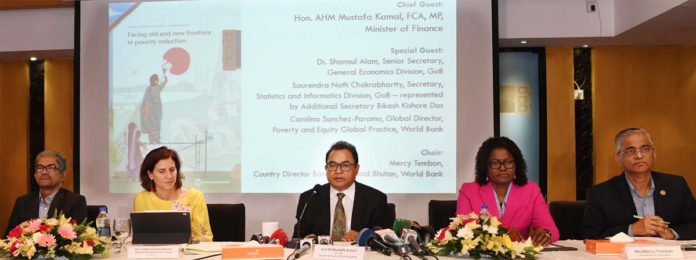DHAKA, Oct 7, 2019 (BSS) – The World Bank today released a study on Bangladesh’s poverty eradication situation saying some eight million people came out of the poverty cycle from 2010 to 2016 while Finance Minister AHM Mustafa Kamal expected it to be reduced significantly in next three years.
“In between 2010-2016, about 8 million Bangladeshis made exit from poverty,” read the report launched by Kamal at a function when he said the government waged a war against hunger and poverty.
He added: “Our extreme poverty rate is less than 10 percent. But, the rate in upper poverty line is hovering around 19-20 percent. It has to be taken care of.”
The report titled ‘Bangladesh Poverty Assessment: Facing Old and New Frontiers in Poverty Reduction’ said Bangladesh progressed significantly in reducing poverty and improving living conditions, mostly driven by labour income.
It, however, showed that robust economic growth continued driving poverty reduction, but at a slower rate and since 2010, while the pace of economic growth increased, the rate of poverty reduction declined.
The report also found the poverty to have reduced unevenly across the country and since 2010, the “historical gap in poverty between the eastern and western divisions re-emerged”.
“In the west, poverty increased in Rangpur Division, stagnated in Rajshahi and Khulna, while in the east, poverty declined moderately in Chattogram, and rapidly in Barishal, Dhaka and Sylhet,” it read.
During the same period, rural areas accounted for about 90 percent of the poverty reduction in the country.
“There was little poverty reduction in urban areas and the share of urban people living in extreme poverty remained the same. This has slowed the national progress in poverty reduction,” the report said.
The report said Industry and services, not agriculture, mostly led poverty reduction in rural areas.
Agriculture growth was slower and less poverty reducing than before.
In urban areas, manufacturing, in particular the garment sector, led the poverty reduction but slowing down of job creation in manufacturing limited the share of families who could benefit.
“Also, poverty rates among self-employed in the service sector increased, creating a setback on urban poverty reduction,” it said.
Kamal said the government in the current year increased the coverage of the social safety net programmes and targeting specific groups and classes of people so that they could come out of poverty.
He also noted that there is no reason even a single person would go back to the poverty line again while the GDP growth rate would not reduce as because of the working age population and the demographic dividend which the country would continue to enjoy.
“The figures that the World Bank has given are of three years old and if the figures are updated, you’ll appreciate our efforts. We believe in one area that growth is the main instrument towards reducing poverty at a faster pace,” Kamal said.
He said in Bangladesh, the objectives are manifold to have an accelerated growth on a sustained basis, growth should be based on quality so that it touches everybody, and everyone should be taken to the mainstream of the economy.
Kamal also renewed the government’s commitment and determination to build a hunger and poverty free country by 2030.
Chaired by World Bank Country Director Mercy Tembon, General Economics Division(GED) Member of the Planning Commission Dr Shamsul Alam, Additional Secretary to the Statistics and Informatics Division Kishore Kumar Das and Global Director, Poverty and Equality of Global Practice of World Bank Carolina Sanchez Paramo spoke as special guests. Senior Economist of the World Bank Maria Genoni made a power-point presentation on poverty assessment.
Referring to the establishment of the countrywide 100 Special economic zones, the Finance Minister said once these come into operation, about 10 million employment opportunities would be created in the next 10 years.
He also renewed his optimism that Bangladesh would be able to attain double digit growth by 2024, by 2028, Bangladesh would be the 27th largest economy in the world while by 2041, Bangladesh would be among the top 20 developed economies of the world.
GED Member Dr Shamsul Alam said the main thirst of the government’s planning is reduction of poverty through job creation.
Noting that the rate of poverty reduction has slightly slowed down in the country as it was 1.7 percent annually up to 2005 which came down at 1.2 percent annually in between 2010-2016, Shamsul emphasized the need for reducing poverty in an accelerated rate to have an impact on growth.
World Bank Country Director Mercy Tembon said the progress that Bangladesh has made in reducing poverty in the last decade is remarkable.
“But, with one out of four people still living in poverty, the country needs to do more, especially in addressing the new frontiers of poverty,” she added.
The World Bank report also said since the country is facing new and re-emerging frontiers of poverty reduction –urban poverty and a re-emerging east-west divide –the report advocates that by adopting traditional and fresh solutions, Bangladesh can reduce poverty faster.



